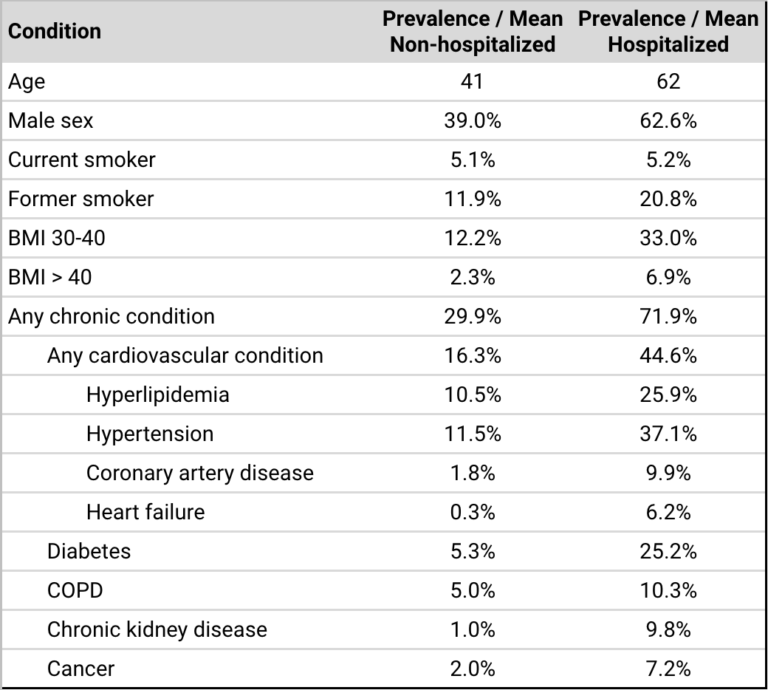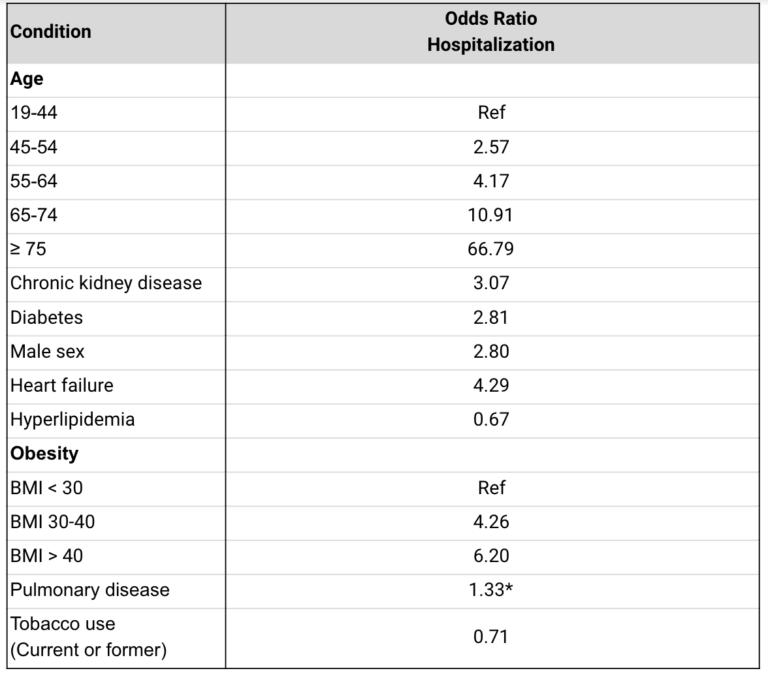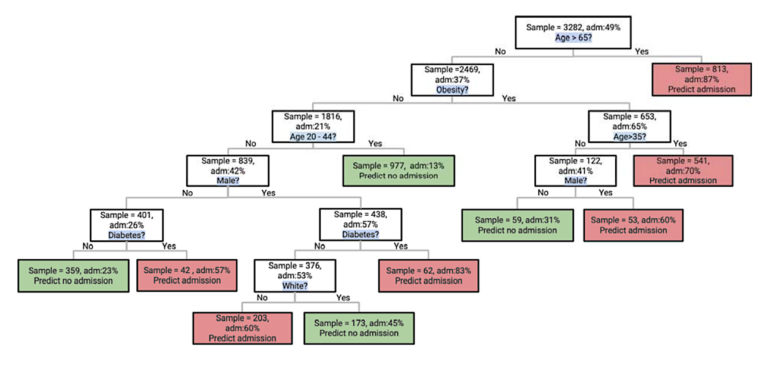Question: Given current data, what are the major risk factors for COVID hospitalization in New York City?
Takeaway: Among those who test positive for COVID-19, age remains by far the most important factor. In both the young and the old, however, heart failure, chronic kidney disease, and diabetes increase risk substantially. Notably, COPD and smoking do not, which suggests COVID hospitalization risk may be more closely linked to overall health than pulmonary health specifically.
This April 2020 cross-sectional study surveys the characteristics of 7,719 patients who were tested for COVID-19 within NYU’s Langone Health hospital system between March 1 and April 2. Patients were tested for COVID if they either showed symptoms suggestive of the virus or based on physician determination.
Of those tested, 4,103 patients tested positive for COVID-19 (48.7%); 1,999 of these positive cases resulted in hospitalization (48.7%); 1,582 of the cases either died, advanced to critical care, or were discharged. Among the 1,582 cases, 650 experienced critical illness (41.1%), 292 died (18.5%), and 932 (58.9%) were discharged without major complications. The mean hospital stay was 4.8 days. COVID-positive patients were an average of 52 years old, and 51% were male, 15% were diabetic, 27% were obese, and 30% had cardiovascular disease.
Tables 1 and 3 from the original paper have been partially recreated below to highlight the most important findings. Age was the most important risk factor for hospitalization, with patients aged 75+ having 66.8 times greater odds of admission than those aged 19-44 and patients aged 65-74 having 10.9 times greater odds of admission. Individuals with chronic kidney disease had 3 times higher rates of hospitalization. Those with diabetes were hospitalized at a 2.8 times higher rate, while those with previous heart failure had a 4.3 times higher rate. Obesity was associated with a 4.3-fold increase in hospitalization for those with a BMI between 30 and 40, and a 6.2-fold increase for those with a BMI over 40. Notably, neither COPD nor current or former tobacco use increased risk of hospitalization; in fact, tobacco users were significantly less likely to be admitted to the hospital than nonusers.

Table 1: Presents the uncorrected prevalence of various patient characteristics in hospitalized and non-hospitalized patients testing positive for COVID-19. Note the ratios between hospitalized and non-hospitalized patients shown here and the risk ratios shown in the table below differ due to correlations between many of these factors.

Table 3: Presents the odds ratios for hospitalization among patients testing positive for COVID in this sample. All associations are statistically significant except for pulmonary disease, which is included because its lack of significance is notable. These are fully adjusted odds ratios — i.e., diabetes increases odds of admission by 2.81 times after correcting for other conditions and demographic factors.
Among those hospitalized, ICU admission was primarily associated with elevations in biomarkers including c-reactive protein, d-dimer and ferritin, as well as markers associated with the course of the disease, such as reduced baseline lymphocyte count, elevated procalcitonin, and low oxygen saturation.
The classification tree below illustrates risk of hospital admission among those who test positive. Notably, while age remains the most significant risk factor, obesity imparts significant vulnerability among those younger than 65, as does diabetes among those young and non-obese.

Figure 1: Classification tree illustrating likelihood of hospitalization based on different risk factors. Obesity and diabetes are major risk factors after accounting for the impact of age.
Overall mortality rates among the hospitalized in this report are similar to those of other recent reports (1). The distribution of risk factors is similar to those associated with other acute respiratory infections, though the researchers note it is surprising that chronic pulmonary disease does not feature more prominently as a risk factor (2). Previous analyses have also found a similar lack of association between smoking and increased risk of pneumonia-related mortality. The biomarkers that predicted future need for critical care among those hospitalized suggest inflammation may play a major role in disease severity, which also may explain the relationship between obesity and increased disease risk (3).
Overall, these results suggest, at least within the population surveyed, that after accounting for age, metabolic disease may play a greater role in increasing COVID risk than pulmonary conditions, and this increased risk may be mediated by the impact of metabolic disease on inflammation. As additional data is gathered across different populations and age groups, we will continue to better understand the various ways and extent to which chronic disease moderates COVID morbidity and mortality.
Notes
- Characteristics of and important lessons from coronavirus disease 2019 (COVID-19) outbreak in China: Summary of a report of 72,314 cases from the Chinese Center for Disease Control and Prevention; Incidence and outcomes of acute lung injury; Epidemiology, patterns of care and mortality for patients with acute respiratory distress syndrome in intensive care units in 50 countries; Preliminary estimates of the prevalence of selected underlying health conditions among patients with Coronavirus Disease 2019 – United States, February 12 – March 28, 2020
- Sepsis and septic shock; The impact of influenza epidemics on hospitalizations; Hospitalizations associated with influenza and respiratory syncytial virus in the United States, 1993-2008
- The pathophysiology and treatment of sepsis; Inflammatory cytokines in general and central obesity and modulating effects of physical activity; Immune cell-derived cytokines contribute to obesity-related inflammation, fibrogenesis and metabolic dysregulation in human adipose tissue
Comments on Factors Associated With Hospitalization and Critical Illness Among 4,103 Patients With COVID-19 Disease in New York City
Something in the study reminds me of the Devor study, not necessarily re foul play, rather, re a number that doesn't sound right and could make a massive difference. Page 10, top: "The... Covid-19 positive study population... (26.8%) obesity." So let me get this straight. In a country where a third are obese, a LOWER PERCENTAGE than that got tested and tested positive? I would've expected the opposite.
These data do not account for biases in hospital admissions. Gender and race should be normalized.
This is the most helpful article I have found on COVID-19. Thank you for seeking to inform, rather than influence, and for analyzing and presenting pertinent data in a way that allows others to assess risk for themselves. We need more of this in mainstream media outlets.
Hopefully we can learn from this data, so that the next time this happens we can isolate like a scalpel instead of like a hand grenade.
Crossfit, we need someone like you to find out why they are manipulating the data. The testing being done to determine whether or not someone is diagnosed as Covid-19 is a Test that was never designed to be used for virus. Furthermore, it does not actually determine whether or not you have Covid-19, but rather a response to stress by our immune system ("can only indicate the presence of viral material during infection and will not indicate if a person was infected and subsequently recovered." https://www.centerforhealthsecurity.org/resources/COVID-19/serology/Serology-based-tests-for-COVID-19.html#sec2).
99% of the deaths in Italy are from those who have 3-4 health complications. These deaths are being mislabeled as deaths because of Covid-19. This is fuzzy science like you tackled with the sugar industry.
I hope you can bring clarity and help the Crossfit community to be able to properly identify the real health concerns and not pseudo science that has been used to lock us down and put more at risk by impacting our community. We know that our best defense is to continue to be active. You guys are great at identifying scams and this may be too big for us to fight as a group, but I hope you can present great information.
The science can not even be properly reviewed if the data is incorrect. The diagnosing of Covid-19 is a mislabeling of the greatest proportion.
Thank you in advance.
I'd like to know the prevalence of hospitalized that are on ACE-inhibitor drugs.
What does 'Ref' mean in table 3
Lane, ref in statistics stands for reference or reference range.
In most medical applications, it’s the ‘normal’ range for most generally healthy portions of the population. Hope that helps.
Also, the "odds ratio" is relative to the reference range. So, if the odds ratio is 2 for something (say, an age group), this means people in that age group are twice as likely to have something happen to them (such as being hospitalized) relative to people in the reference range. For normal epidemiology (eg, did people who ate butter fare worse than those who did not), you want odds ratios at least of two or preferably more. The larger the odds ratio, the more you can consider the association to be possibly causation. In this case, the odds ratios show what happens if you're older or have one of the listed characteristics.
It is well known that aging typically associates with one or more co-morbidities. I would like to see an analysis in which the co-morbidities were separated from age. In other words, does a normal-weight 75 yo male with no hypertension, diabetes, heart disease, etc. still have the same risk of hospitalization as an obese, diabetic 75 yo male? I would assume not, but it seems that everyone stratifies by age alone and not by age and co-morbidities.
Mike,
We actually have this data, or at least a strong indication of it! The CDC has two reports - one of which I've read closely, one of which I just found now.
https://www.cdc.gov/mmwr/volumes/69/wr/mm6915e3.htm?s_cid=mm6915e3_w
https://www.cdc.gov/mmwr/volumes/69/wr/mm6913e2.htm?s_cid=mm6913e2_w
The latter is the one I know well. Table 2 provides the key - among those hospitalized, the rate of ICU entry among those age 19-64 WITH an underlying condition is HIGHER than the rate of ICU entry of those 65+ WITHOUT an underlying condition. Now, there is still absolutely an effect of age independent of comorbidity status, which we see in both those with and without comorbidities. But the impact of comorbidity on risk seems to be at least as great as that of age. (And who knows if we would see greater consistency if we started to suss out indicators of comorbidity that stop short of frank disease, like prediabetes)
The former, at a glance, shows that the share of all subjects with an underlying condition remains very high across all age groups. While you are right to suggest that the prevalence of these conditions increases with age, I know without looking it up that some number less than 94.4% of all Americans age 65+ have at least one of those underlying conditions.
The comorbidities are clearly increasing risk independent of age, across all age groups. And given that we now have two clear axes which are pushing increased disease risk - age and a handful of specific comorbidities - that probably begins to point us toward the mechanism.
There will be more discussion on this front, surely.
Factors Associated With Hospitalization and Critical Illness Among 4,103 Patients With COVID-19 Disease in New York City
11